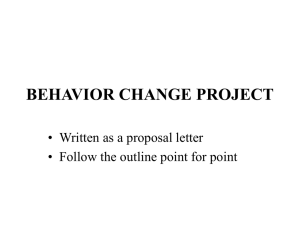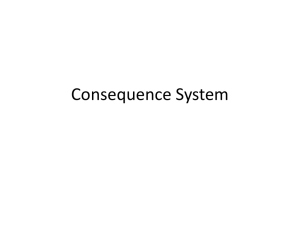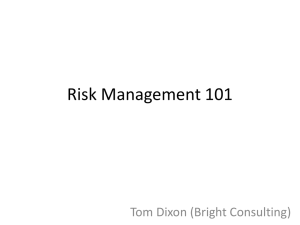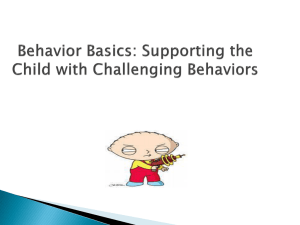How to fill Death Notification and Certificate
advertisement
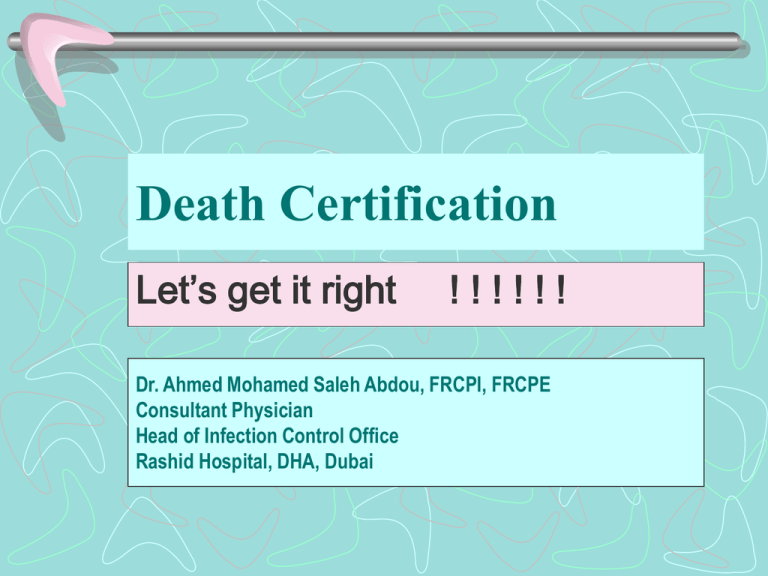
Death Certification Let’s get it right !!!!!! Dr. Ahmed Mohamed Saleh Abdou, FRCPI, FRCPE Consultant Physician Head of Infection Control Office Rashid Hospital, DHA, Dubai The last service that doctors can offer their patients is to provide a certificate of death which is properly completed with a reasonably accurate diagnosis. Horner JS, Horner J. Do doctors read forms?J R Soc Med 1998;91(7):371-376 Cause of Death Statement Part I A. Immediate Cause “most recent condition” Due to, or as a consequence of: B. Intervening Causes “next oldest condition” Due to, or as a consequence of: C. Underlying Cause “oldest, original, initiating condition” Part II. OTHER SIGNIFICANT CONDITIONS: Conditions contributing to death but not resulting in the underlying cause of death in Part I Cause of Death Statement Part I A. Immediate Cause “ Intraperitoneal haemorrhage ” Due to, or as a consequence of: B. Intervening Cause “ Ruptured secondary deposit in liver ” Due to, or as a consequence of: C. Underlying Cause “ Adenocarcinoma of ascending colon ” Part II. OTHER SIGNIFICANT CONDITIONS: Conditions contributing to death but not resulting in the underlying cause of death in Part I “ Non-insulin dépendent diabètes mellitus ” Vital Statistics - Mortality Database • The information from the cause of death statement (CODs) is the basis for the national mortality database • Local health officials might use mortality statistics ,,, ,,, • Surveillance of disease prevalence in a society • Prioritize governmental decisions and actions in regard to health care • Proper allocation of funds for research and educational programs Decedent’s Family Benefits • Legal, medical and psychological benefits: • • • • Help settle the estates of the deceased. Claim life insurance or other death benefits. Receive government benefits. Pursue any legal actions they might wish to initiate. • Valuable in developing a family history or “genealogy” ? Unfortunately …. the process is flawed because of a significant data entry error rate, particularly, in assigning the cause of death information provided on death certificates is frequently incomplete and has limitations Studies have reported that the documentation of the cause of death in death certificates is very poor, with error rates ranging from 16% to 40% Studies have reported that the documentation of the cause of death in death certificates is very poor, with error rates ranging from 16% to 40% which … questions the validity of information from the cause-of-death registry for administrative or scientific purposes. and hence … Accuracy of the national mortality statistics. ? ? The root problem … general lack of training in death certification during medical school and postgraduate training programs. Few physicians are actually trained in completing death certificates or on the significance of death certification,,, and,,,, many take little interest in its accuracy because of no perceived benefit. Often,,,, a physician's first encounter with the death certificate occurs upon his first patient death. Problems With Proper Completion and Accuracy of the Cause-of-Death Statement Ann E. Smith Sehdev, MD; Grover M. Hutchins, MD Arch Intern Med. 2001;161:277-284. completeness Hopefully, next tutorial will help you avoid mistakes and to be complete and accurate when writing cause-of-death statements accuracy Definitions and Guidelines Physicians without training in death certificates completion,,,, may not even understand the correct definitions of the Death Certification Terminology Death Certification Terminology • Underlying cause of death • Immediate cause of death • Intermediate causes of death • Mechanism of death • Manner of death Underlying “Primary” Cause of Death • The disease or injury however brief or prolonged that triggered / initiated the dependent / related sequence of events that led to death we can say that …………………………… • “But for” this or that particular underlying event, death would not have occurred. Underlying “Primary” Cause of Death a competent cause of death is etiologically specific • various carcinomas, • atherosclerotic coronary artery disease, • chronic obstructive pulmonary disease (emphysema and chronic bronchitis), and • human immunodeficiency virus infection. • chronic viral hepatitis • road traffic accident Underlying “Primary” Cause of Death must appear on the lowest completed line • Coded to one of the International Statistical Classification of Diseases and Related Health Problems (ICD-10) categories and then to a disease-specific cause of death. Immediate “Direct” Cause of Death the immediate cause of death is a complication and sequela of the underlying cause of death, that directly precedes death the last event that occurred before death as specific as possible ,,, Escherichia coli sepsis should not be a general concept ,,, organ failure Intermediate “Intervening” Causes of Death a disease(s), condition(s), or complication(s) that occurs somewhere in time between the underlying and immediate causes of death For death certification, these conditions should be recorded in logical pathophysiologic sequence • The time interval between initial insult and death can be instantaneous as in a massive spontaneous intracranial hemorrhage. • Or ……………… • There may be hours, days, weeks, months, or even years between initial event and death… - atherosclerosis ,,,,, - bronchogenic carcinoma,,,, etc. • The actual underlying cause of death may be overlooked or ignored if a considerable time interval, since the initial insult, has passed For examlpe ,,,,, “a man suffers a trans-abdominal gunshot wound with perforation of the colon.” After months of treatment, he develops peritonitis, septicemia, disseminated intravascular coagulopathy, hepatic and renal failure, bronchopneumonia, and adult respiratory distress syndrome, and dies. the gunshot wound remains to be the underlying cause of death. Similarly,,,,, if a person dies from complications of quadriplegia ten years after a diving accident in which he sustained a cervical fracture with contusions of the spinal cord … … 10 years the cervical injuries due to the diving accident remain to be the underlying cause of death. Another example ,,,,, • .. an individual with massive abdominal injuries secondary to a motor vehicle accident (MVA) may require prolonged hospitalization. • That patient might develop acute peritonitis, sepsis with seizures, and subsequently expire as a result of aspiration pneumonia; • yet, the blunt traumatic injuries due to MVA to the abdomen are the underlying cause of death. Aspiration pneumonia Acute peritonitis, sepsis and seizures Traumatic abdominal injuries due to MVA however ,,, the sequence of events must be dependent & related an independent supervening factor that would not be a reasonable and foreseeable consequence of the initial disease or injury … … …… would alter the cause of death. For example ,,,,, If the MVA patient inadvertently received a lethal dose of medication ,,,,, ,,,,, that error would represent an independent supervening factor that is not a reasonable and foreseeable consequence of the traumatic injuries. lethal dose of xxxxxxxxx lethal dose of xxxxxxxxx Traumatic abdominal injuries due to MVA with acute peritonitis, sepsis, seizures and aspiration pneumonia lethal dose of xxxxxxxxx Traumatic abdominal injuries due to MVA with acute peritonitis, sepsis, seizures and aspiration pneumonia Mechanism (Mode) Of Death A physiologic derangement or biochemical disturbance produced by a cause of death ,,,,,,,,,,,,,,,,,,,,,,,,,,,,,,,,,,,,,, the means by which The cause of death exerts its lethal effect. Mechanisms of death are not etiologically specific and potentially can result from more than one cause ,,,,,,,,,,, thus are of little value when cited as an underlying cause of death. Common Mechanisms of Death congestive heart failure pulmonary oedema cardiac arrhythmias hypoxaemia sepsis exsanguinations renal failure hepatic insufficiency multiorgan failure Important Message ….. • Mechanism / modes of death lack etiologic specificity and are unacceptable substitutes for the underlying cause of death. • May only be used if qualified by an appropriate cause of death. • A mechanism of death should never stand alone on the death certificate. Specificity = accurate ICD-10 coding • Neoplastic diseases: anatomical site ,,, cell type ,,, grade ,,, primary or secondary ,,, etc. • Pneumonias: organism responsible ( Strep pnemoniae ,,, Pneumocystis carinii ,,, etc) • Septicaemia: causative organism ( Pseudomonas aeuroginosa ,,, mecicillin resistant Staphylococcal aureus ,,, etc.) • Strokes: type (infarction or haemorrhage) ,,, anatomical site of the lesion ( right middle cerebral artery ) ,,, etc. Cardio-respiratory arrest • Regardless of the cause or the manner of death, the heart “cardio” eventually stops beating “arrest” and the lungs “respiratory” cease to breathe “arrest”. • Cardio-respiratory arrest is a description of being dead and provides no information whatsoever as to what underlying injury or disease was responsible for the individual’s death. Definition Of Death Complete & Persistent Cessation Of Respiration & Circulation “Cardiopulmonary Arrest” a mechanistic term that is meaningless for purposes of death certification; Cardio respiratory arrest is not a cause of death; it is not etiologically specific. It is a description of being dead, not a cause of death. • The cause-of- death statement contains two parts, appropriately named Part I and Part II. Part I A. Due to, or as a consequence of: B. Due to, or as a consequence of: C. Part II. OTHER SIGNIFICANT CONDITIONS: Conditions contributing to death but not resulting in the underlying cause of death in Part I • Part I is designed so that a sequence of conditions leading to death may be reported in a cascade order. • Part II is for reporting conditions that pre-existed or co-existed and contributed to death, but did not result in the the cause reported in Part I. • Part I will be considered first. • To facilitate coding, ONE CONDITION per line, starting with the most recent condition on the top line and going backward in time on progressively lower lines, “Sequential Part I Format”. Part I A. Most recent condition (Cardiac tamponade) Due to, or as a consequence of: B. Next oldest condition ( Ruptured myocardial infarction) Due to, or as a consequence of: C. Oldest (original, initiating) condition (Atherosclerotic coronary artery disease) • • • • Each condition can cause the one on the line above it. It is not always necessary to use all of the lines in Part I. Although rarely needed, extra lines may be added. The top line (A) should always be used. • The cause-of-death information from each death YOU certify is coded and becomes part of the mortality data base. • Doctors are expected to complete the cause of death statement to the best of their knowledge and belief. Part I A. Cardiac tamponade Due to, or as a consequence of: B. Myocardial infarction with left ventricular rupture Due to, or as a consequence of: C. Atherosclerotic coronary artery disease • This cause-of-death statement provides complete information, and is of greater potential use for research, statistics, public health decision making and policy setting, and law-making. • It also provides complete information for the family and others who use the death certificate. • It may be necessary to use three or more lines in Part I. Part I A. Upper gastrointestinal hemorrhage Due to, or as a consequence of: B. Ruptured esophageal varices Due to, or as a consequence of: C. Cirrhosis of the liver Due to, or as a consequence of: D. Chronic alcohol abuse • In the example, "chronic alcohol abuse" is the underlying cause of death. • "Upper gastrointestinal hemorrhage" is the immediate cause of death. • Each of the other two conditions is an intermediate cause of death because it falls somewhere in the sequence between the underlying and immediate cause of death. • In this example, floppy mitral valve syndrome is the underlying cause of death-- the specific condition that started the downhill course of events that led to death. Part I A. Cerebral infarction Due to, or as a consequence of: B. Thrombo-embolism to right internal carotid artery Due to, or as a consequence of: C. Thrombo-embolism from bacterial endocarditis of mitral valve Due to, or as a consequence of: D. Floppy mitral valve syndrome • A major goal when writing a cause-of-death statement is to report an underlying cause of death that is as etiologically specific as possible based on current medical knowledge. • To-date, there is no known, reportable cause of floppy mitral valve syndrome, thus, it is a "competent" underlying cause of death. • In this example, "atherosclerotic coronary artery disease" is the underlying cause of death. Part I A. Acute myocardial infarction Due to, or as a consequence of: B. Atherosclerotic coronary artery disease Due to, or as a consequence of: C. • "acute myocardial infarction" was the final and fatal complication of the coronary artery disease and is the immediate cause of death (the final condition that was a complication of the underlying cause of death and which directly culminated in death). • Note that in this case, only two lines were needed to complete the cause-of-death statement. • You can see the value of reporting the atherosclerotic coronary artery disease as the underlying cause of death because there are a number of conditions that may cause acute myocardial infarction. Part I A. Acute myocardial infarction Due to, or as a consequence of: B. Atherosclerotic coronary artery disease Due to, or as a consequence of: C. • Examples of other possible causes of acute myocardial infarction include coronary artery vasculitis, coronary artery anomalies, embolism from other diseases at other sites, trauma, etc. • If only the acute myocardial infarction were reported, a user of the cause-of-death statement would not know which underlying condition existed in the patient. • ------------------------------------------------------------------------------------------------------------------------------------------------------------------------------------------------------------------------------------------------Part I A. Acute myocardial infarction Due to, or as a consequence of: B. Coronary artery vasculitis Due to, or as a consequence of: C. • -----------------------------------------------------------------------------------------------------------------------------------------------------------------------------------------------------------------------------------• ------------------------------------------------------------------------------------------------------------------------------------------------------------------------------------------------------- • ------------------------------------------------------------------------------------------------------------------------------------------------------------------------------------------------------------------------------------------------Part I A. Acute myocardial infarction Due to, or as a consequence of: B. Coronary artery anomalies Due to, or as a consequence of: C. • -----------------------------------------------------------------------------------------------------------------------------------------------------------------------------------------------------------------------------------• ------------------------------------------------------------------------------------------------------------------------------------------------------------------------------------------------------- • ------------------------------------------------------------------------------------------------------------------------------------------------------------------------------------------------------------------------------------------------Part I A. Acute myocardial infarction Due to, or as a consequence of: B. Coronary artery embolism Due to, or as a consequence of: C. • -----------------------------------------------------------------------------------------------------------------------------------------------------------------------------------------------------------------------------------• ------------------------------------------------------------------------------------------------------------------------------------------------------------------------------------------------------- • It may not always be possible to report an immediate cause of death. • Consider a 60 year-old man who had widely metastatic, terminal prostate carcinoma, whose death was expected, and who died at home. Permission for autopsy could not be obtained. • It might be necessary to write the cause-of-death statement as: Part I A. Metastatic Adenocarcinoma of the prostate Due to, or as a consequence of: B. Due to, or as a consequence of: C. • Insufficient information existed to cite an immediate cause-ofdeath such as pneumonia, midbrain metastasis, or some other cause. • In cases such as this one, Line A serves as both the underlying and immediate cause of death, “Single Line Part I Format”. • It is permissible to express uncertainty or presumption. • One may qualify the cause-of-death statement with words such as "probable" or "presumed“. Part I A. Presumed cardiac dysrhythmia Due to, or as a consequence of: B. Toluene poisoning Due to, or as a consequence of: C. Inhalation of spray paint • In general, one need not use such terms because the cause-ofdeath statement is an opinion based on all available information and need only meet the test of being "more likely than not“. • There are situations, however, where the inclusion of such wording may be helpful to indicate some degree of uncertainty. • Patients may die of fatal nonspecific complications such as gastrointestinal hemorrhage. • In some cases, there may have been insufficient time to fully evaluate the patient for the underlying disease, or inability to obtain permission for autopsy. • In such cases, this approach may be used: Part I A. Gastrointestinal hemorrhage Due to, or as a consequence of: B. Undetermined natural causes Due to, or as a consequence of: C. • Of course, one should be reasonably certain that only natural causes were involved and that there is no other reasonably probable underlying cause of death. • Using such an approach lets a user of the cause-of-death statement know that thought was given about the underlying cause of death and it wasn't just omitted through oversight. • Using the same scenario as on the previous screen, but adding that the patient had symptoms and signs strongly pointing to peptic ulcer disease as the cause of the gastrointestinal hemorrhage, it would be preferable to write the cause-of-death statement as: Part I A. Gastrointestinal hemorrhage Due to, or as a consequence of: B. Probable peptic ulcer disease Due to, or as a consequence of: C. • Medical judgment is required when picking the best alternative for writing the cause-of-death statement. • Truthfulness, completeness, and reasonable accuracy should be the goal • Convenience and expedience should not play a role when deciding upon a cause-of-death statement. • This is an example of a POORLY WRITTEN cause-of-death statement which, unfortunately, is typical of many death certificates that are completed by physicians. Part I A. Septic shock Due to, or as a consequence of: B. Gram-negative sepsis Due to, or as a consequence of: C. • One must immediately ask "Why did this patient have gramnegative sepsis? that's not something that most healthy people get, and spontaneous occurrence must be extremely rare." • The truth is that the patient had multiple sclerosis and a chronic indwelling catheter for a neurogenic bladder, which resulted in the urinary tract infection. • An accurate and complete cause-of-death statement is: Part I A. Gram-negative pseudomonas sepsis Due to, or as a consequence of: B. Urinary bladder infection Due to, or as a consequence of: C. Indwelling catheter for neurogenic bladder Due to, or as a consequence of: D. Multiple sclerosis • This example is much more informative and of greater potential use than the preceding example. • It tells the specific story and sequence of events that led to this patient's death. • So far, each of the examples has involved only a single underlying disease entity. • But what if more than one condition (disease or injury) seemed to have added together to cause death? Part I A. Due to, or as a consequence of: B. Due to, or as a consequence of: C. Part II. OTHER SIGNIFICANT CONDITIONS: Conditions contributing to death but not resulting in the underlying cause of death in Part I • " Part II may be used to report conditions that co-existed or pre-existed and contributed to death but did not result in the underlying cause of death reported in Part I. • This case is a classic example of the intended use of Part II. • Assume that the patient had a clinical course strongly pointing to coronary atherosclerosis with acute myocardial infarction. Part I A. Acute myocardial infarction Due to, or as a consequence of: B. Atherosclerotic coronary artery disease Due to, or as a consequence of: C. Part II. OTHER SIGNIFICANT CONDITIONS: Conditions contributing to death but not resulting in the underlying cause of death in Part I ------------------------------------------- • However, the patient also had hypertension which was thought to have been partially responsible for cardiomegaly which increased cardiac oxygen demand and facilitated the adverse effects of the coronary artery disease. • This case is a classic example of the intended use of Part II. • Assume that the patient had a clinical course strongly pointing to coronary atherosclerosis with acute myocardial infarction. Part I A. Acute myocardial infarction Due to, or as a consequence of: B. Atherosclerotic coronary artery disease Due to, or as a consequence of: C. Part II. OTHER SIGNIFICANT CONDITIONS: Conditions contributing to death but not resulting in the underlying cause of death in Part I Essential hypertension • The hypertension co-existed and contributed to death, but did not cause the underlying cause of death in Part I. • Hypertension, then, is correctly reported in Part II as an other significant condition.. • Part II can also be used another way. • Consider a patient with AIDS who dies with complications including pneumocystis carinii pneumonia and disseminated mycobacterium avium complex • clinically, the pneumocystis pneumonia seemed the most significant in causing terminal pulmonary problems: Part I A. Pneumocystis carinii pneumonia Due to, or as a consequence of: B. Acquired immune deficiency syndrome Due to, or as a consequence of: C. Human immunodeficiency virus infection Part II. OTHER SIGNIFICANT CONDITIONS: Conditions contributing to death but not resulting in the underlying cause of death in Part I -----------------------------------------------------• The most important condition should be cited in Part I and the lesser important one(s) should be cited in Part II. • This example fits nicely with the intended use of Part II. • The disseminated mycobacterium infection did contribute to death. • Although it resulted from the underlying cause of death reported in Part I, it did not result in death directly. Part I A. Pneumocystis carinii pneumonia Due to, or as a consequence of: B. Acquired immune deficiency syndrome Due to, or as a consequence of: C. Human immunodeficiency virus infection Part II. OTHER SIGNIFICANT CONDITIONS: Conditions contributing to death but not resulting in the underlying cause of death in Part I Disseminated mycobacterium avium infection • More than one condition may be reported in Part II, and it is often necessary to do so. • A third way to use Part II is for reporting risk factors. • For example, the cause-of-death statement for a man who was a heavy cigarette smoker and who died of Klebsiella pneumonia as a complication of emphysema may be written as: Part I A. Community-acquired Klebsiella pneumonia Due to, or as a consequence of: B. Emphysema Due to, or as a consequence of: C. Part II. OTHER SIGNIFICANT CONDITIONS: Conditions contributing to death but not resulting in the underlying cause of death in Part I Cigarette smoking • One might argue that whether the cigarette smoking has caused the emphysema?. In a specific case, however, it may be difficult to know that a cause-and-effect relation existed. • The same method of reporting risk factors may be used for other risk factors (such as diabetes mellitus, obesity, alcohol intoxication, intravenous drug abuse, etc.) that existed in the patient and is relevant to the cause-of-death sequence reported in Part I. Part I A. Cerebral toxoplasmosis Due to, or as a consequence of: B. Acquired immune deficiency syndrome Due to, or as a consequence of: C. Human immunodeficiency virus infection Part II. OTHER SIGNIFICANT CONDITIONS: Conditions contributing to death but not resulting in the underlying cause of death in Part I Intravenous drug abuse • It is not necessary to include the words "risk factor," but doing so does clarify the nature of the reported condition. Onset - to - Death time interval • Part I also contains space on each line to indicate the interval between the onset of each condition cited and death. • It should be apparent that the intervals should get longer (or at least not get shorter) as one reads from top to bottom. • The interval since diagnosis should NOT be stated if a condition is known to have existed for a longer period of time. Onset - to - Death time interval • These intervals are stated as accurately as possible. • Intervals may also be approximate and generic intervals such as "seconds," "minutes," "hours," "days," "weeks," "months," "years," and "decades" are acceptable. • “unknown" is also acceptable if such is the case. Manner Of Death • The manner of death is a description of the circumstances surrounding death, how the cause of death arose, or circumstances in which the cause of death transpired • The manner of death is classified as natural when death is due solely to disease, and unnatural when death is caused or contributed to by injury or poisoning. • There are generally considered to be five manners of death: natural, accident, suicide, homicide, and undetermined N.B. Some jurisdictions include another category, therapeutic complication Natural Death A natural death is any death that is exclusively (100%) the direct result of the progression of a natural, medically recognized disease process. If an injury (or poisoning ) of any sort causes or contributes to death, - no matter how trivial the contribution, - no matter how long after the injury death occurred, the manner of death cannot be natural. Natural Death Cancer Chronic Hepatitis B infection Systemic lupus erythematosus Chronic obstructive pulmonary disease Atherosclerotic coronary artery disease The foreseeable and expected complications of these diseases would also be classified as natural Unnatural Death Any death that is not the direct and complete result of a natural, medically recognized disease. Death where an outside intervening influence, - either directly or indirectly is contributory to the individual’s demise, or - accelerates and exacerbates an underlying disease process to such a degree as to cause death. Natural Death Vs Unnatural Death Fulminant hepatitis due to acute hepatitis B infection would be classified as natural Fulminant hepatitis due to acetaminophen overdose (homicide, suicide or accident) would be classified as unnatural Natural Death Vs Unnatural Death Acute bacterial bronchopneumonia may be the direct cause of death following: aspiration following an epileptic fit homicidal stab to the chest suicidal drug overdose with subsequent coma and aspiration blunt traumatic chest injuries in a motor vehicle accident What would change in each instance, is the manner of death Principles … “Cause of Death Statement” • Make every effort to report an etiologically specific underlying cause of death. • Try to use a Sequential Part I Format, if possible. • Err on the side of reporting too much rather than too little. • DO NOT report mechanistic terminal events such as: cardiopulmonary arrest Asystole ventricular fibrillation electromechanical dissociation • DO NOT report symptoms or signs. • DO NOT report a condition if its existence in the patient is obvious based on another reported condition. • DO NOT oversimplify. • DO NOT use abbreviations. Scenario ,,, A chronic alcoholic • developed cirrhosis, jaundice, ascites, portal-systemic shunt, caput medusae, hyperammonemia, asterixis, hepatic encephalopathy, • and then … … • respiratory arrest followed by cardiac arrest and death These conditions are to be listed in approximate sequence from most recent to the oldest …. and …… the conditions to remain for writing the cause-of death statement are determined by applying the Principles… Rationale … • Cardiac arrest and respiratory arrest are mechanistic terminal events. • Asterixis, caput medusae, ascites, and jaundice in this case were either symptoms or signs. • Hyperammonemia is just one component of a complex process, and to cite it would be oversimplification. • Portal-systemic shunt was eliminated because its existence seemed apparent based on the other reported conditions, although it could have been retained to err on the side of reporting too much rather than too little. • Cirrhosis and hepatic encephalopathy remain, are major conditions in the sequence that led to death, and enable the use of a Sequential Part I format. • Chronic alcohol abuse was retained because it was the underlying cause of death. • Now, the cause-of-death statement is easily written as shown on the following screen. • By using the Principles, the following cause-of-death statement may be written: Part I A. Hepatic encephalopathy Due to, or as a consequence of: B. Cirrhosis of the liver Due to, or as a consequence of: C. Chronic alcohol abuse Part II. OTHER SIGNIFICANT CONDITIONS: Conditions contributing to death but not resulting in the underlying cause of death in Part I • The cause-of-death statement tells a complete story about how this patient died compared to how someone else may have died of the same underlying cause of death. • In other words, not all patients with hepatic encephalopathy have cirrhosis, and not all patients with cirrhosis acquired it from chronic alcohol abuse. Scenario ,,, ,,, A 72 year old woman • had a 20 year history of type II diabetes mellitus for which insulin had been required for about 3 years. • 5 years previously she had a stroke (cerebral infarction) ,, left her bed-ridden and dependent on long-term care. • work up revealed; carotid bruits and marked occlusion of the carotid arteries by atherosclerosis. later, she developed decubiti which became infected with proteus mirabilis, leading to septic shock and death • By using the Principles, the following cause-of-death statement may be written: Part I A. Proteus mirabilis infection of decubitus ulcers Due to, or as a consequence of: B. Remote cerebral infarction Due to, or as a consequence of: C. Carotid artery atherosclerosis Part II. OTHER SIGNIFICANT CONDITIONS: Conditions contributing to death but not resulting in the underlying cause of death in Part I Type II Diabetes mellitus • Diabetes was listed in Part II because it is a risk factor for atherosclerosis, and it was also felt to predispose the patient for soft tissue infection. • In this example, diabetes mellitus is the underlying cause of death. Part I A. End-stage renal disease Due to, or as a consequence of: B. Diabetic nephropathy Due to, or as a consequence of: C. Type I diabetes mellitus Part II. OTHER SIGNIFICANT CONDITIONS: Conditions contributing to death but not resulting in the underlying cause of death in Part I Ischaemic heart disease • Always remember to specify whether your patient’s diabetes was type one, or type two and the complication or sequence that led to death. Death Certification Errors • Death certification errors are common and range from minor to severe • We attribute errors to house staff inexperience, fatigue, time constraints, unfamiliarity with the deceased, and perceived lack of importance of the death certificate Mechanisms of death should not be used in cause-of-death statements Abbreviations should not be used anywhere in cause-of-death statements Citing a nonspecific process as the underlying cause of death without qualification, ie, unspecified etiology Nonsequential listing of conditions The underlying cause of death (disease or condition that initiated the morbid train of events leading to death) is listed in Part II Hypertension is another significant condition that likely contributed to but did not cause death The man’s alive Sir, for he has open’d one eye. The doctor declar’d him Dead two hours since & he must remain Dead Sir, so I shall preceed with the Inquest A Coroner’s Inquest. London: ( Courtesy of the United States National Library of Medicine The man’s alive Sir, for he has open’d one eye. The doctor declar’d him Dead two hours since & he must remain Dead Sir, so I shall preceed with the Inquest A Coroner’s Inquest. London: ( Courtesy of the United States National Library of Medicine Death in The Elderly - Principles • It would be considered unlikely that patients would die of old age, with no apparent disease or injury, in an acute hospital • Coexistent medical problems that may have contributed to death should be sought • The certifier should not overlook possibilities of: abuse or neglect ,,, inconspicuous injury ,,, suicide ,,, hypothermia and hyperthermia • Dementia should not be overlooked Death in The Elderly Generally, old age is not acceptable as a cause of death Aging is not a disease, and “old age” does not contribute to vital statistics. Old age should only be given as the sole cause of death in very limited circumstances. These are that: • • • • You have personally cared for the deceased over a long period (many months or years) You have observed a gradual decline in your patient's general health and functioning You are not aware of any identifiable disease or injury that contributed to the death You are certain that there is no reason that the death should be reported to the coroner (unnatural) • By using the Principles, the following cause-of-death statement may be written: Part I A. Subdural haematoma Due to, or as a consequence of: B. Blunt force head trauma Due to, or as a consequence of: C. Fall Part II. OTHER SIGNIFICANT CONDITIONS: Conditions contributing to death but not resulting in the underlying cause of death in Part I Senile dementia • In this case, an injury event (the fall) seems to have been brought about by natural disease (senile dementia), but death clearly resulted from trauma. When no specific condition could be ascribed ,,,,,,, An option for certification include “undetermined natural causes” as a last resort choice The man’s alive Sir, for he has open’d one eye. The doctor declar’d him Dead two hours since & he must remain Dead Sir, so I shall preceed with the Inquest A Coroner’s Inquest. London: ( Courtesy of the United States National Library of Medicine Therapy-Related Death Therapeutic maneuvers may contribute to death For example … a patient with acute myelogenous leukemia is treated with chemotherapy that leads to neutropenia While neutropenic, the patient develops invasive pulmonary aspergillosis and dies natural course of disease was altered by therapeutic intervention with a known risk of complication Therapy-Related Death The standard of care was followed but the manner of death was unnatural, therapy-related Therapy-related death does not equate with, imply, or assume malpractice or negligence However … Neglect or failure of a health care provider to intervene in a patient’s management when medically necessary may result in a reportable unnatural death A Coroner’s Inquest. London: ( Courtesy of the United States National Library of Medicine Juror (the local barber): The man’s alive Sir, for he has open’d one eye Coroner: Sir, the doctor declar’d him Dead two hours since & he must remain Dead Sir, so I shall proceed with the Inquest A Coroner’s Inquest. London: ( Courtesy of the United States National Library of Medicine Juror (the local barber): The man’s alive Sir, for he has open’d one eye Coroner: Sir, the doctor declar’d him Dead two hours since & he must remain Dead Sir, so I shall proceed with the Inquest
